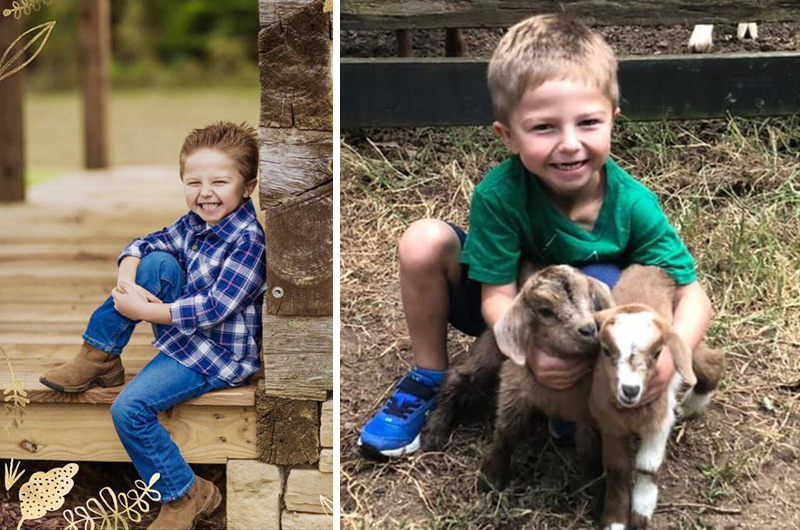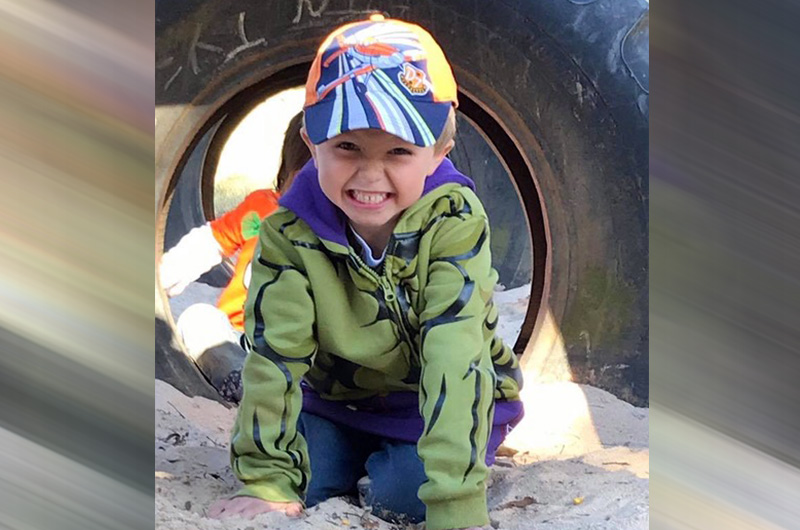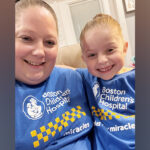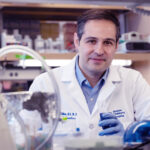Making up for lost time: Living with esophageal atresia

Whether he’s riding his dirt bike, learning how to swim, playing with his dogs and cats, or herding the chickens and goats on his family’s farm, Landen Spry loves staying active and being outside. “He’s making up for lost time,” says his mother, Jolene.
She isn’t exaggerating. During his young life, he’s spent nearly a year in and out of the hospital. Although a standard ultrasound exam revealed a hole in his heart, it wasn’t until Landen was born that Jolene and her husband, Stacy, discovered the full extent of his health challenges. It was then that he was diagnosed with VACTERL association, a syndrome that can include vertebral, anal, cardiac, tracheal, esophageal, renal, and limb abnormalities. Landen has some, but not all, of these anomalies. Among them is esophageal atresia (EA), in which the esophagus develops in two separate segments that do not connect, making it impossible to receive enough nutrition by mouth.

A long road
Clinicians at his local hospital in North Carolina addressed some of Landen’s medical concerns, but when he finally came home, his parents realized that he was aspirating when he tried to feed. “They didn’t fully understand the severity of this problem,” says Stacy. His health began to decline. Based on a friend’s recommendation, the Sprys reached out to nurse Dori Gallagher, clinical coordinator for the Esophageal and Airway Treatment Center at Boston Children’s Hospital.
Upon the family’s arrival, Landen was also diagnosed with an esophageal stricture, a narrowing of the esophagus that can make it difficult to swallow. But when the center’s medical director, Dr. Michael Manfredi, attempted to dilate the stricture, he and surgical director Dr. Russell Jennings uncovered a host of other anomalies. “We were so relieved that they were able to identify the problems, and that they were fixable,” Jolene remembers. “We just never thought it would take so long.”

Undergoing jejunal interposition
Indeed, what was to be a 30-day hospital stay turned into almost 11 months as clinicians tried to stretch and soften Landen’s esophagus to keep new strictures from forming. A detached esophagus and infection complicated his progress, leading to more hospital visits. When he was finally healthy enough, the little boy underwent jejunal interposition, a procedure in which Dr. Jennings and his colleagues replaced the missing section Landen’s esophagus with a section of the middle part of his small intestine.
The time in Boston was made easier by the family’s use of the Hospitality Homes program, which matches patient families with volunteer hosts. “We’ve learned that if you can make it to Boston, the hospital will help connect you to resources,” says Jolene. “Things will unfold and reveal themselves.”

‘We wouldn’t want to be anywhere else’
Still, the ups and downs were stressful for the family — and for Landen, who has since undergone a revision of the jejunal interposition and a Roux-en-Y bypass, which has improved his digestion. Yet his parents say they wouldn’t change their decision to come to Boston. “Looking back, we wouldn’t want to be anywhere else for care,” says Stacy. “The staff here is always thinking and planning for us, even when we’ve felt like we can’t anymore.”
Now 7, Landen is embracing being back home with the rest of his family, his pets, and his friends. And although he will likely face additional procedures in the future, his parents are looking on the bright side. “This has taught us patience,” says Jolene. “It’s made us stronger — and helped us realize how resilient kids can be.”
Learn about the Esophageal and Airway Treatment Center.
Related Posts :
-

Hard and beautiful at the same time: Five lessons of raising a medically complex child
When they learned they were expecting a baby, Michelle and Stephen Strickland were delighted. The South Carolina couple looked forward ...
-

‘Challenge accepted’: Sophia takes on a brain tumor
In 2023, Sophia Mordini landed the role of a lifetime. A competitive dancer, the 12-year-old would play Clara in her company’...
-

A case for Kennedy — and for rapid genomic testing in every NICU
Kennedy was born in August 2025 after what her parents, John and Diana, describe as an uneventful pregnancy. Soon after delivery, ...
-

The journey to a treatment for hereditary spastic paraplegia
In 2016, Darius Ebrahimi-Fakhari, MD, PhD, then a neurology fellow at Boston Children’s Hospital, met two little girls with spasticity ...





